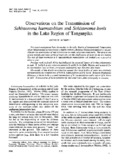| dc.description.abstract | Previous investigations have shown that in the Lake Region of Sukumaland, Tanganyika, where Schistosoma haematobium is highly endemic, Bulinus (Physopsis) nasutus is responsible for the transmission of that schistosome in small, temporary rain pools. This area is one of low rainfall, and large artificial reservoirs are the chief source of water in the dry season. The role of these reservoirs in S. haematobium transmission was studied over a period of about a year.
Previous work in South Africa had indicated the potential danger of bovine schistosomes to man. S. bovis is a very common parasite in cattle in the Lake Region, and a search for its intermediate host or hosts, previously unidentified, was therefore also made.
The results of this double investigation suggest that large bodies of water are relatively unimportant in the transmission of both S. haematobium and S. bovis. Bulinus (Physopsis) africanus is shown to be a second intermediate of S. haematobium and a vector of S. bovis as well. Transmission of these parasites by this snail takes place principally in streams. | en |

